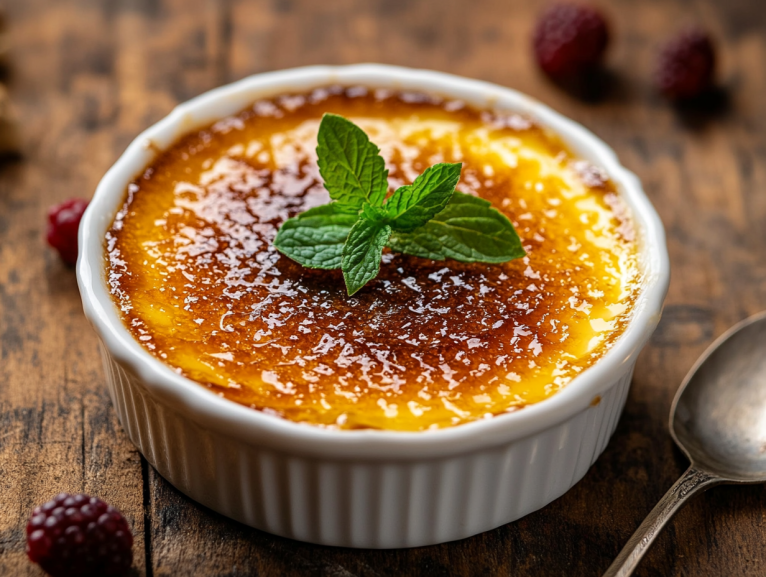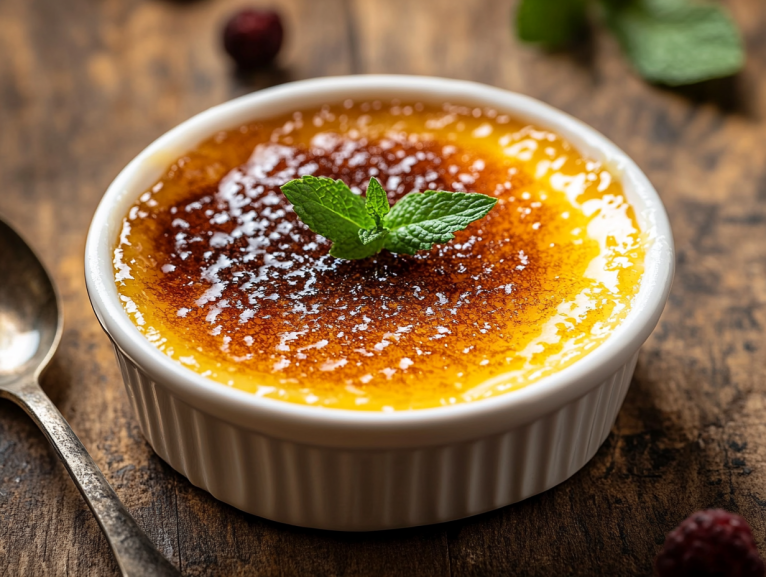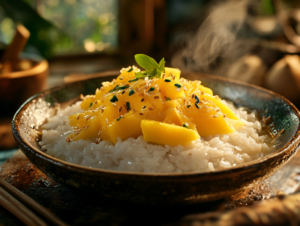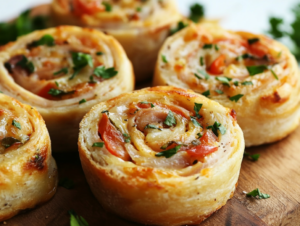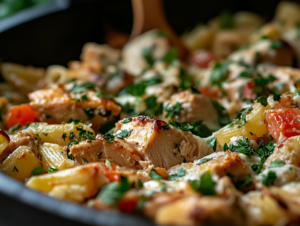Crème brûlée, translating to “burnt cream” in French, is a timeless dessert that epitomizes culinary elegance. With its silky custard base crowned by a crisp, caramelized sugar crust, this delicacy offers a harmonious blend of textures and flavors that have captivated dessert enthusiasts for centuries.
A Glimpse into History
The origins of crème brûlée are a subject of culinary debate. The earliest known recipe appears in François Massialot’s 1691 cookbook, “Cuisinier royal et bourgeois.” Interestingly, in a 1740 edition, Massialot referred to a similar recipe as “crême à l’Angloise,” or ‘English cream’, further casting doubt on its origins. The dessert was introduced at Trinity College, Cambridge, in 1879 as “Trinity Cream” or “Cambridge burnt cream,” with the college arms “impressed on top of the cream with a branding iron”.
The Allure of Crème Brûlée
What makes crème brûlée truly enchanting is the contrast between its creamy custard and the brittle caramelized topping. The act of tapping the hardened sugar to reveal the luscious custard beneath is a sensory delight, making each serving a moment of indulgence.
Crafting the Perfect Crème Brûlée
Servings: 4
Prep Time: 15 minutes
Cook Time: 45 minutes
Total Time: 1 hour (plus at least 2 hours to chill)
Ingredients
- 2 cups heavy cream
- 1 whole vanilla bean (or 1 teaspoon vanilla bean paste or vanilla extract)
- 6 large egg yolks
- ½ cup granulated sugar (plus extra for topping)
- Heaping ¼ teaspoon salt
Directions
- Prepare the Cream Mixture: In a medium saucepan, bring the heavy cream to a gentle simmer over medium heat. If using a vanilla bean, split it lengthwise, scrape out the seeds, and add both the seeds and the pod to the cream. Once it reaches a simmer, remove from heat and let it steep for about 15 minutes to infuse the flavors.
- Preheat the Oven: Set your oven to 325°F (163°C) and position the rack in the middle.
- Whisk Egg Yolks and Sugar: In a mixing bowl, whisk together the egg yolks, granulated sugar, and salt until the mixture becomes pale and slightly thickened.
- Combine Mixtures: Gradually pour the warm cream into the egg yolk mixture, whisking continuously to prevent the eggs from cooking. If you used a vanilla bean, strain the mixture through a fine-mesh sieve to remove the pod and any solids.
- Prepare Ramekins: Place four 8-ounce ramekins in a large roasting pan. Divide the custard mixture evenly among the ramekins.
- Create a Water Bath: Pour hot water into the roasting pan until it reaches halfway up the sides of the ramekins. This bain-marie ensures gentle and even cooking.
- Bake: Carefully transfer the roasting pan to the oven. Bake for 30 to 40 minutes, or until the custards are set but still have a slight wobble in the center.
- Cool and Chill: Remove the ramekins from the water bath and let them cool to room temperature. Once cooled, cover them with plastic wrap and refrigerate for at least 2 hours, or up to 3 days.
- Caramelize the Sugar: When ready to serve, sprinkle about 1½ to 2 teaspoons of granulated sugar evenly over each custard. Using a kitchen torch, caramelize the sugar until it forms a deep golden crust. Alternatively, you can place the ramekins under a broiler set to high heat, watching closely to prevent burning.
- Serve: Allow the caramelized sugar to harden for a minute or two. Serve immediately and enjoy the delightful contrast of textures.
Nutritional Information (per serving):
- Calories: 588
- Total Fat: 50g
- Saturated Fat: 29g
- Cholesterol: 382mg
- Sodium: 281mg
- Total Carbohydrates: 33g
- Sugars: 32g
- Protein: 6g
Note: Nutritional values are approximate and can vary based on specific ingredients used.
Tips for Success
To achieve the perfect crème brûlée, start by selecting high-quality heavy cream, as it is essential for a rich and velvety custard. The quality of the cream directly affects the dessert’s texture and overall taste. When it comes to flavoring, traditional crème brûlée is infused with vanilla, but don’t be afraid to experiment with different infusions such as citrus zest, coffee, or lavender for a unique twist. These variations can add depth and personalization to the classic recipe.
Caramelizing the sugar is a crucial step that gives crème brûlée its signature crisp topping. The best way to achieve an even caramelized crust is by using a kitchen torch, which allows for better control over the heat. If you don’t have a torch, you can use a broiler, but be sure to watch closely to prevent burning. Another advantage of crème brûlée is its make-ahead convenience. The custards can be prepared a few days in advance and stored in the refrigerator. However, for the best results, the sugar should be caramelized just before serving to maintain its irresistible crunch.
Exploring Variations
While the classic vanilla version remains timeless, crème brûlée is incredibly versatile and can be adapted to suit different flavors. For a rich and indulgent twist, chocolate crème brûlée can be made by incorporating melted dark chocolate into the custard mixture. Espresso lovers can enjoy an espresso crème brûlée by adding a shot of espresso or instant coffee granules to the cream, creating a bold and aromatic flavor. Similarly, matcha crème brûlée offers an earthy, slightly bitter contrast to the sweet custard by mixing in a teaspoon of matcha powder.
For a fall-inspired treat, pumpkin spice crème brûlée can be made by incorporating pumpkin purée along with warm spices such as cinnamon, nutmeg, and cloves. Coconut crème brûlée introduces a tropical flair by replacing half of the heavy cream with coconut milk, resulting in a slightly lighter but equally delicious version. Finally, citrus-infused variations like lemon or orange crème brûlée add a refreshing and zesty note by mixing in finely grated citrus zest. These variations allow for endless creativity while maintaining the essence of this beloved dessert.
Pairing Crème Brûlée with the Perfect Drink
Crème brûlée pairs beautifully with a variety of beverages, enhancing its flavors and creating a well-rounded dessert experience. A classic choice is dessert wine, such as Sauternes, Tokaji, or a late-harvest Riesling, as their natural sweetness and acidity complement the caramelized sugar topping. For coffee lovers, a freshly brewed espresso or a strong black coffee balances the custard’s creamy sweetness with its bitter contrast.
If you prefer something bubbly, champagne or sparkling wine offers a crisp and refreshing counterbalance to the dessert’s richness, making it an elegant pairing for special occasions. For those who enjoy a hint of liqueur, a small pour of Baileys Irish Cream or Amaretto adds a nutty, creamy dimension that blends seamlessly with the custard’s silky texture. No matter the choice of beverage, the right pairing can elevate the crème brûlée experience, turning it into an unforgettable indulgence.
Frequently Asked Questions
1. Can I make crème brûlée without a torch?
Yes! You can caramelize the sugar under a broiler. Place the ramekins on the top rack and watch closely to ensure the sugar melts evenly without burning.
2. Why is my crème brûlée grainy?
A grainy texture usually happens if the eggs are cooked too quickly. To prevent this, make sure to temper the egg yolks by slowly adding the warm cream while whisking.
3. How do I know when the custard is done baking?
The center should still have a slight wobble when gently shaken. It will continue to set as it cools. Overbaking can cause a curdled texture.
4. Can I store crème brûlée in the fridge?
Yes! The custard can be made ahead and stored in the fridge for up to three days. However, only caramelize the sugar just before serving to maintain its signature crunch.
5. Can I use milk instead of heavy cream?
Heavy cream is essential for the luxurious texture of crème brûlée. Substituting with milk will result in a thinner custard that may not set properly.
The Magic of the First Bite
Few desserts provide the satisfaction of cracking through a golden, glassy sugar crust to reveal a luscious, creamy custard beneath. Whether you’re making crème brûlée for a dinner party, a romantic night in, or just to treat yourself, this dessert never fails to impress.
With just a few ingredients and a bit of technique, you can master this timeless French classic in your own kitchen. So grab your ramekins, a kitchen torch, and indulge in the magic of crème brûlée!
Print
The Best Crème Brûlée Recipe – Silky, Rich, and Easy to Make
5 Stars 4 Stars 3 Stars 2 Stars 1 Star
No reviews
- Author: Ferial Hammachi
Ingredients
- 2 cups heavy cream
- 1 whole vanilla bean (or 1 teaspoon vanilla bean paste or vanilla extract)
- 6 large egg yolks
- ½ cup granulated sugar (plus extra for topping)
- Heaping ¼ teaspoon salt
Instructions
- Prepare the Cream Mixture: In a medium saucepan, bring the heavy cream to a gentle simmer over medium heat. If using a vanilla bean, split it lengthwise, scrape out the seeds, and add both the seeds and the pod to the cream. Once it reaches a simmer, remove from heat and let it steep for about 15 minutes to infuse the flavors.
- Preheat the Oven: Set your oven to 325°F (163°C) and position the rack in the middle.
- Whisk Egg Yolks and Sugar: In a mixing bowl, whisk together the egg yolks, granulated sugar, and salt until the mixture becomes pale and slightly thickened.
- Combine Mixtures: Gradually pour the warm cream into the egg yolk mixture, whisking continuously to prevent the eggs from cooking. If you used a vanilla bean, strain the mixture through a fine-mesh sieve to remove the pod and any solids.
- Prepare Ramekins: Place four 8-ounce ramekins in a large roasting pan. Divide the custard mixture evenly among the ramekins.
- Create a Water Bath: Pour hot water into the roasting pan until it reaches halfway up the sides of the ramekins. This bain-marie ensures gentle and even cooking.
- Bake: Carefully transfer the roasting pan to the oven. Bake for 30 to 40 minutes, or until the custards are set but still have a slight wobble in the center.
- Cool and Chill: Remove the ramekins from the water bath and let them cool to room temperature. Once cooled, cover them with plastic wrap and refrigerate for at least 2 hours, or up to 3 days.
- Caramelize the Sugar: When ready to serve, sprinkle about 1½ to 2 teaspoons of granulated sugar evenly over each custard. Using a kitchen torch, caramelize the sugar until it forms a deep golden crust. Alternatively, you can place the ramekins under a broiler set to high heat, watching closely to prevent burning.
- Serve: Allow the caramelized sugar to harden for a minute or two. Serve immediately and enjoy the delightful contrast of textures.

